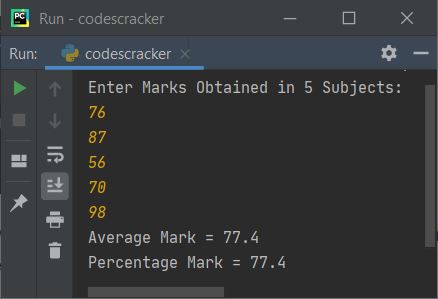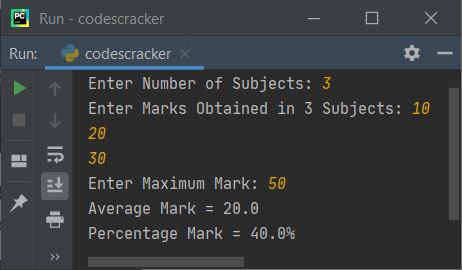- Python Basic Programs
- Python Program Examples
- Python Print Hello World
- Python Get Input from User
- Python Add Two Numbers
- Add Subtract Multiply Divide
- Python Check Even or Odd
- Python Check Prime or Not
- Python Check Alphabet or Not
- Python Check Vowel or Not
- Python Check Leap Year or Not
- Check Reverse equal Original
- Check Positive Negative Zero
- Python Check Armstrong or Not
- Python Check Palindrome or Not
- Python Check Perfect Number
- Python Find Reverse of Number
- Python Count Digits in Number
- Python Add Digits of Number
- Sum of First and Last Digits
- Python Product of Mid Digits
- Sum of Squares of Digits
- Interchange Digits of Number
- Python Sum of n Numbers
- Python Print ASCII Values
- Python Swap Two Numbers
- Python Swap Two Variables
- Python Fahrenheit to Celsius
- Python Celsius to Fahrenheit
- Python Display Calendar
- Python Days into Years, Weeks
- Find Largest of Two Number
- Find Largest of Three Number
- Python Print Fibonacci Series
- Generate Armstrong Numbers
- Python Make Simple Calculator
- Python Add Binary Numbers
- Binary Number Multiplication
- Python Mathematical Programs
- Find Sum of Natural Numbers
- Find Average of n Numbers
- Python Print Multiplication Table
- Print Table using Recursion
- Python Find Average Percentage
- Python Find Grade of Student
- Find Square Root of Number
- Python Print Prime Numbers
- Find Numbers Divisible by
- Python Find Factors of Number
- Python Find Factorial of a Number
- Python Find HCF & LCM
- Python Kilometres to Miles
- Python Find Area of Square
- Python Find Area of Rectangle
- Python Find Area of Triangle
- Python Find Area of Circle
- Python Find Perimeter of Square
- Find Perimeter of Rectangle
- Python Find Perimeter of Triangle
- Find Circumference of Circle
- Python Simple Interest
- Python Solve Quadratic Equation
- Python Different Set of Operations
- Python Display Powers of 2
- Python Find nCr & nPr
- Python Pattern Programs
- Python Print Pattern Programs
- Python Print Diamond Pattern
- Python Print Floyd's Triangle
- Python Print Pascal's Triangle
- Python List Programs
- Python Count Even/Odd in List
- Python Positive/Negative in List
- Python Even Numbers in List
- Python Odd Numbers in List
- Python Sum of Elements in List
- Sum of Odd/Even Numbers
- Python Element at Even Position
- Python Element at Odd Position
- Python Search Element in List
- Python Largest Number in List
- Python Smallest Number in List
- Python Second Largest in List
- Python Second Smallest in List
- Python Insert Element in List
- Python Delete Element from List
- Python Multiply Numbers in List
- Swap Two Elements in List
- Python 1D Array Program
- Python Linear Search
- Python Binary Search
- Python Insertion Sort
- Python Bubble Sort
- Python Selection Sort
- Remove Duplicates from List
- Python Reverse a List
- Python Merge Two List
- Python Copy a List
- Python Conversion Programs
- Python Decimal to Binary
- Python Decimal to Octal
- Python Decimal to Hexadecimal
- Python Binary to Decimal
- Python Binary to Octal
- Python Binary to Hexadecimal
- Python Octal to Decimal
- Python Octal to Binary
- Python Octal to Hexadecimal
- Python Hexadecimal to Decimal
- Python Hexadecimal to Binary
- Python Hexadecimal to Octal
- Python Matrix Programs
- Python Add Two Matrices
- Python Subtract Two Matrices
- Python Transpose Matrix
- Python Multiply Matrices
- Python String Programs
- Python Print String
- Python Find Length of String
- Python Compare Two Strings
- Python Copy String
- Python Concatenate String
- Python Reverse a String
- Python Swap Two Strings
- Python Uppercase to Lowercase
- Python Lowercase to Uppercase
- Python Check Substring in String
- Python Count Character in String
- Count Repeated Characters
- Python Count Word in Sentence
- Python Count Each Vowels
- Python Capitalize Character
- Python Capitalize Word in String
- Python Smallest/Largest Word
- Remove Spaces from String
- Remove Duplicate Character
- Remove Vowels from String
- Remove Punctuation from String
- Python Remove Word in String
- Python Remove Duplicate Words
- WhiteSpace to Hyphens
- Replace Vowels with Character
- Replace Character in String
- Python Sort String in Alphabetical
- Sort Word in Alphabetical Order
- Extract Number from String
- Python Check Anagram Strings
- Python File Programs
- Python Read a File
- Python Write to File
- Python Append Text to File
- Python Copy Files
- Python Merge Two Files
- Python Counts Characters in File
- Python Count Words in File
- Python File Content in Reverse
- Python Lines Contains String
- Python Delete Line from File
- Python Capitalize Word in File
- Python Replace Text in File
- Replace Specific Line in File
- Python Find Size of File
- Python List Files in Directory
- Python Delete Files
- Python Misc Programs
- Python Reverse a Tuple
- Python Merge Two Dictionary
- Python bytes to String
- Python bytearray to String
- Generate Random Numbers
- Python Print Address of Variable
- Python Print Date and Time
- Python Get IP Address
- Python Shutdown/Restart PC
- Python Tutorial
- Python Tutorial
Python Program to Calculate Average and Percentage Marks
In this article, you will learn and get code in Python, to calculate and print average and percentage marks based on marks entered by user at run-time. Here are the list of programs:
- Calculate Average and Percentage Marks based on Marks obtained in 5 Subjects
- Modified Version of above Program. This program uses for loop to receive marks from user
- Allow User to define the number of subjects, maximum mark along with marks obtained in all subjects
Calculate Average & Percentage Marks in Python
To calculate average and percentage marks in python, you have to ask from user to enter marks obtained in 5 subjects. And then calculate and print average and percentage marks as shown in the program given below:
print("Enter Marks Obtained in 5 Subjects: ") mOne = int(input()) mTwo = int(input()) mThree = int(input()) mFour = int(input()) mFive = int(input()) sum = mOne+mTwo+mThree+mFour+mFive avg = sum/5 perc = (sum/500)*100 print(end="Average Mark = ") print(avg) print(end="Percentage Mark = ") print(perc)
Here is the sample run of the above Python program, shows how the average and percentage marks of student gets printed on output:

The screenshot given above shows the initial output. Now enter marks obtained in 5 subjects one by one and then
press ENTER key to calculate and print average and percentage marks as shown in the following screenshot:

In above program, the following statement:
print(end="Average Mark = ")
is used to print Average Mark = without a newline. Because the print() statement automatically prints a newline after printing all the things inside its braces.
Note - The end= ends the line with the thing present inside "" after it. That is, the next thing starts from the same line (in above program).
Note - In above program, if we've to receive marks obtained in 10 subjects, then we've to write the input code again and again 10 number of times. Therefore, let's use the loop to do the same task in dynamic way.
Receive Marks using for Loop
This program does the same job as of previous program. The only difference is, this program uses for loop to receive the marks obtained in 5 subjects. The for loop also uses to calculate the sum of all subject's mark:
mark = [] tot = 0 print("Enter Marks Obtained in 5 Subjects: ") for i in range(5): mark.insert(i, int(input())) for i in range(5): tot = tot + mark[i] avg = tot/5 perc = (tot/500)*100 print(end="Average Mark = ") print(avg) print(end="Percentage Mark = ") print(perc)
This program produces the same output as of previous program.
Note - The range() function returns a sequence of values. By default, the value starts with 0 and increments by 1. It stops before a number specified as argument of the function.
Therefore from above program, the following code:
for i in range(5):
is used to execute the following statement:
mark.insert(i, int(input()))
five times with value of i from 0 to 4. That is, input from user gets received and stored in the list mark[] one by one, in this way:
- First value gets stored in mark[0]
- Second value gets stored in mark[1]
- Third value gets stored in mark[2]
- and so on upto
- Fifth value gets stored in mark[4]
Get Number of Subject, Obtained Marks, Maximum Mark from User
Now let's create a program that calculates average and percentage marks based on marks obtained in N number of subjects.
This program allows user to provide or define all the things such as total number of subject, marks obtained in all subjects, and maximum mark. After receiving these inputs from user, the program calculate and prints the average and percentage marks:
mark = [] totMark = 0 print(end="Enter Number of Subjects: ") totSub = int(input()) print(end="Enter Marks Obtained in " + str(totSub) + " Subjects: ") for i in range(totSub): mark.insert(i, int(input())) print(end="Enter Maximum Mark: ") maxMark = int(input()) for i in range(totSub): totMark = totMark + mark[i] avg = totMark/totSub perc = (totMark/(totSub*maxMark))*100 print("Average Mark = " + str(avg)) print("Percentage Mark = " + str(perc) + "%")
Here is its sample run:

Now supply inputs say 3 as number of subjects, 10, 20, 30 as marks obtained in 3 subjects, and finally 50 as maximum mark of subject. Here is the sample output based on these user inputs:

Note - The str(totSub) is used to convert totSub to string. Because the + operator adds value of same type, otherwise it gives an error.
Same Program in Other Languages
- Java Calculate Average and Percentage Marks
- C Calculate Average and Percentage Marks
- C++ Calculate Average and Percentage Marks
« Previous Program Next Program »